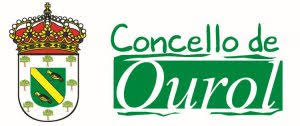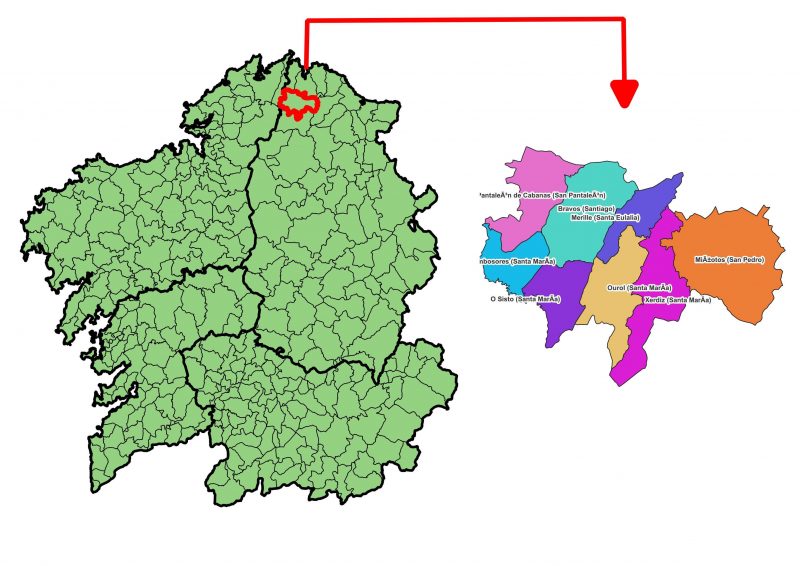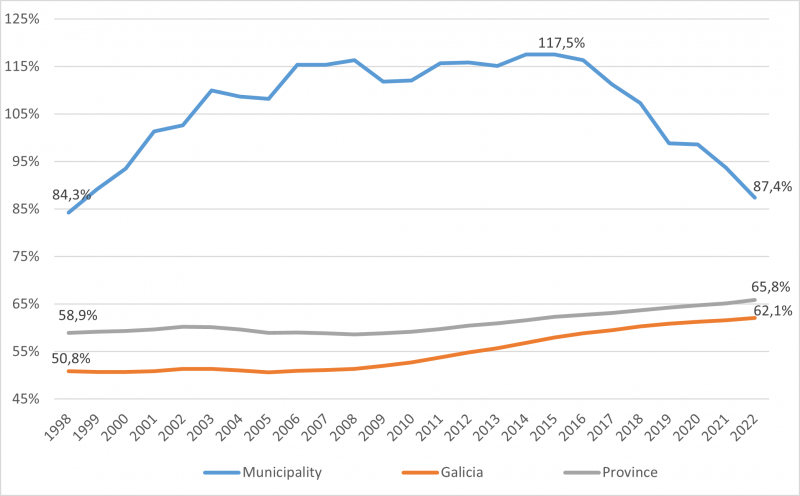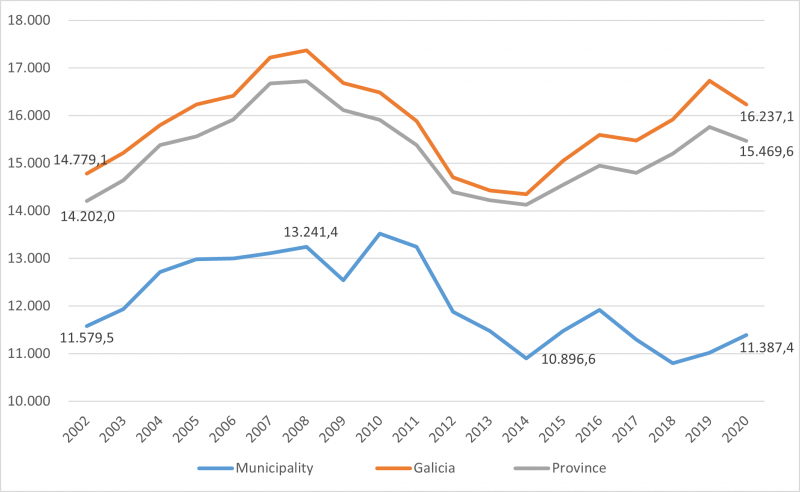
Introduction
The Municipality of Ourol located in the region of Mariña Occidental, in the north of the province of Lugo and 90 kilometres from the provincial capital, is a territory close to the coast, with 1,000 inhabitants in 2022, with a surface area of 142 square kilometres. It has a degree of urbanisation typical of the Sparsely Populated Area, according to the Galician Institute of Statistics.
It is part of the Terras de Miranda Rural Development Group (RDG1).

Population and demographic structure
The population of Ourol registers a continuous loss of inhabitants in the period from 1991 to 2022, with a decrease of 960 inhabitants, which represents a decrease of almost 50%. Ourol far exceeds the -1.5% recorded in Galicia and the -15.7% observed in the province of Lugo during the same period.
In Ourol, the demographic decline coincided with a change in the age distribution, with a progressive ageing of the population. In the period from 2002 to 2022, the most affected age groups were those over 64 years of age, which experienced a reduction of -40%. In addition, both the working-age population (16-64 years) and the young population suffered reductions of -26% and -17% respectively. In the last decade, from 2012 to 2022, only the over-64 age group showed a decline of -28%, while the under-64 age groups showed a slight demographic recovery. As a result, the working-age population has stabilised and even fallen below the over-64 population during the entire period 2002-2018. Subsequently, the adult population increased while the population over 64 continued its downward trend.
Demographic ageing is reflected in the narrowing of the base of the population pyramid and the expansion of the top, as well as an increase in the median age. The average age of the inhabitants in 2022 reached 56 years. Women have a higher median age than men, at 58 for women and around 54 for men.
The General Dependency Ratio (GDR) in Ourol peaked in 2014 at 117%. From then on, it shows a decreasing trend until 2022, where it stands at 87%, twenty percentage points above the Galician and provincial index. In recent years, the demographic dynamics of Ourol has shown a relatively favourable trend, in contrast to that experienced until then.

Population dynamics in Ourol.

Evolution of the total dependency ratio of Ourol, Lugo and Galicia.
Economy
The evolution of Gross Disposable Product (GDP) reveals a growth dynamic that contrasts with that observed in the Galician municipalities as a whole and in the province of Lugo. Throughout the 2010s, GDP growth rates were consistently negative, with the exception of the period between 2016 and 2018, during which the total GDP of the municipality grew by 26%. In contrast, the growth rates of the territorial groups always remained in positive territory until 2020. However, between 2018 and 2020, GDP contracted at all three territorial levels, registering a decrease of 8% in Ourol, in line with the reductions observed in Galicia, with -7.7%, and Lugo, with -7.2%.
The GDP of Ourol experienced a reduction of -10.6% between 2010 and 2020, a decline significantly higher than that experienced in Galicia, with -2%, and Lugo, with -4%.
The Gross Disposable Income (GDI) in the period analysed from 2002 to 2020, experienced moments of remarkable growth and even recorded an increase of 3.3% during the year of the pandemic, unlike Galicia and the province as a whole. Despite this, it shows a decrease of -1.6% over the period analysed, in contrast to the growth in income in Galicia as a whole, with 9.8%, and in the province of Lugo as a whole, with 9%. The per capita GDI of Ourol stands at 11,380 euros in 2020.
Using the register of social security affiliations as an estimate of municipal employment, between 2011 and 2022, Ourol experienced an increase of 2% in total affiliations, a figure significantly lower than the 8% recorded at the Galician level, but higher than the slight increase of 0.1% at the provincial level.
The distribution of affiliations in 2022 reveals similarities between Ourol, Galicia and Lugo, with the tertiary sector having the highest number of affiliations in all three cases, followed by the secondary sector and, finally, the primary sector. The primary sector in Ourol shows similarities with the distribution of affiliations in the province of Lugo, accounting for around 18% of affiliations in the municipality and 11.6% in the case of Lugo, while in Galicia it only represents 5%. This sector shows a significant loss of affiliations in the primary sector, both at municipal, provincial and regional level, with a reduction of 40% since 2011 in the municipality and 20% in Galicia and Lugo.
The secondary sector represents between 18% and 23% of the affiliations in the three territories and the tertiary sector is positioned as the main productive sector in affiliations, representing approximately 60% in Ourol and more than 70% in the territorial groups. Specifically, Ourol registered an increase of 10.5%, Galicia experienced a decrease of -3% and the province of Lugo a reduction of -11.4%.
The tertiary sector gained weight with an increase in the number of affiliates of 27% in Ourol, a figure significantly higher than the increase observed in Galicia as a whole, with 14%, and in Lugo as a whole, with 9.6%. It is the main sector of the productive sector in terms of affiliations, representing 60%.
Therefore, the productive structure of Ourol is characterised by an important weight of the primary sector, close in number of affiliations to the secondary sector, while the tertiary sector is consolidated as the one with the highest rate of affiliation. These results suggest that both the local and regional economies may have experienced less impact during the pandemic, thanks to the productive structure where the agri-food sector has a greater weight in the total number of affiliations.
In 2022, Ourol had an activity rate of 72% in 2022, which is a notable difference of twenty percentage points compared to the average for Galicia and Lugo. Likewise, an increase in the employment rate is observed, reaching close to 60% in 2022, significantly exceeding the figures recorded at regional level. The unemployment rate shows a gradual decrease from 12.2% in 2011 to 11.5% in 2022, approaching the rates of the territorial groups.
In Ourol there is a marked difference in the employment and activity rates, which far exceed those recorded in both Galicia and the province of Lugo. This disparity is even more pronounced in the case of the employment rate, which has experienced significant growth since 2013, standing at 60.6% in 2022, indicating a strong recovery of employment in the territory after an initial phase of decline.
Likewise, the activity rate of the municipality shows a steady increase throughout the period analysed, contrary to the downward trend observed in Galicia and Lugo. This increase is reflected in a substantial difference of twenty percentage points over the provincial and regional rates in 2022, standing at 72%.
As for the unemployment rate, although the municipality of Ourol began the period with a relatively low rate in 2011, at 12%, it experienced fluctuations that led to an increase during the year of the pandemic, finally standing above the rates of the territorial set in the period analysed.

Evolution of Gross Disposable Income per inhabitant in Ourol, Lugo and Galicia.

Evolution of employment, unemployment, and activity rates in the municipality of Ourol.
Energy resources
Ourol has a significant supply of energy from different renewable sources, namely wind, hydro and, to a lesser extent, solar photovoltaic. With a total of 154 wind turbines and an installed capacity of 134 MW, Ourol achieves an estimated production of between 249,300 and 302,000 MW per year. On the other hand, it has an installed hydroelectric power capacity of 15 MW, in addition to 8 kilowatts of photovoltaic solar energy. However, diversification of renewable energy sources is essential to strengthen the municipality’s energy resilience and maximise its economic potential. The expansion of these and other forms of renewable energy would not only help reduce dependence on a single source but could also generate new economic and employment opportunities in the area.
The electricity consumption of Ourol in 2023 was 2,364.04 MWh. Residential consumption was 854.74 MWh. Utility consumption, including municipal services, was 635.21 MWh. Industry consumed 874.09 MWh.
Energy Policy Councils
Date of the first meeting:
30th April 2024
Number of participants:
10 people
Profile of participants:
- Staff of the municipality of Ourol: mayor
- EC4RURAL project staff: UVIGO, ESPAZOCOOP
- Citizens
Evaluation of the energy situation
The mayor showed interest in being part of the EC4RURAL project.
For the municipality of Ourol it is of great interest to participate in the energy community, due to the fact that the population is very dispersed. To be part of the energy community it is not necessary to be a resident or be registered in the municipality, it is necessary to be a UCSP (Unified Code of Supply Points) holder and accept to be part of the community.
Dialogue between the parties
During the meeting, there was an open dialogue between the citizens and the municipality about photovoltaic energy production. This is the limitation for self-consumption installations, which will prevent the creation of energy communities. The possibility of creating energy communities without self-consumption is discussed. Differences in the amount of investment are reported if there are different installation points. In this situation, it would be necessary to decide how to manage these cost differences. It is important to consider the design of the process so that there is no discrimination and, if there is, that it is positive discrimination towards those who are in a worse starting position.
The minimum number of members of the rural energy community must be at least 2 UCSP. The lifetime of the rural energy community is 25 years. Solar panels typically have a lifespan of 25 to 30 years, barring accidents or breakdowns. The maintenance costs of the installations include proper operation, cleaning, insurance of the installations and internet connection.
Other models are mentioned, such as those promoted by the municipalities of Arteixo and Begonte, with the creation of communities for the sale of energy, with larger installations than the model on which the project is based.
The differences between the self-consumption model and the sale of energy are emphasised, as the energy community must choose between self-consumption and the sale of energy.
Conclusions
It is mentioned that there are difficulties in taking the community initiative forward. This was due to insufficient involvement of the municipality and lack of motivation without the participation of the municipality. As a result, the Energy Policy Council was not established.



